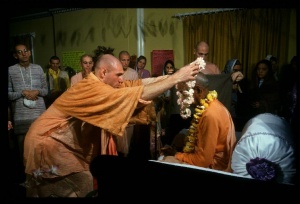CC Adi 10.25 (1975): Difference between revisions
(Vanibot #0027: CCMirror - Mirror CC's 1996 edition to form a basis for 1975) |
(Vanibot #0020: VersionCompareLinker - added a link to the Version Compare feature) |
||
| Line 2: | Line 2: | ||
<div style="float:left">'''[[Sri Caitanya-caritamrta (1975)|Śrī Caitanya-caritāmṛta (1975)]] - [[CC Adi (1975)|Ādi-līlā]] - [[CC Adi 10 (1975)|Chapter 10: The Trunk, Branches and Subbranches of the Caitanya Tree]]'''</div> | <div style="float:left">'''[[Sri Caitanya-caritamrta (1975)|Śrī Caitanya-caritāmṛta (1975)]] - [[CC Adi (1975)|Ādi-līlā]] - [[CC Adi 10 (1975)|Chapter 10: The Trunk, Branches and Subbranches of the Caitanya Tree]]'''</div> | ||
<div style="float:right">[[File:Go-previous.png|link=CC Adi 10.24 (1975)|Ādi-līlā 10.24]] '''[[CC Adi 10.24 (1975)|Ādi-līlā 10.24]] - [[CC Adi 10.26 (1975)|Ādi-līlā 10.26]]''' [[File:Go-next.png|link=CC Adi 10.26 (1975)|Ādi-līlā 10.26]]</div> | <div style="float:right">[[File:Go-previous.png|link=CC Adi 10.24 (1975)|Ādi-līlā 10.24]] '''[[CC Adi 10.24 (1975)|Ādi-līlā 10.24]] - [[CC Adi 10.26 (1975)|Ādi-līlā 10.26]]''' [[File:Go-next.png|link=CC Adi 10.26 (1975)|Ādi-līlā 10.26]]</div> | ||
{{CompareVersions|CC|Adi 10.25|CC 1975|CC 1996}} | |||
{{RandomImage}} | {{RandomImage}} | ||
==== TEXT 25 ==== | ==== TEXT 25 ==== | ||
| Line 18: | Line 17: | ||
<div class="synonyms"> | <div class="synonyms"> | ||
tāṅhāra—his; bhaginī—sister; | tāṅhāra—his; bhaginī—sister; damayantī—of the name Damayantī; prabhura—of the Lord; priya—dear; dāsī—maidservant; prabhura—of the Lord; bhoga-sāmagrī—cooking materials; ye—who; kare—does; vāra-māsi—throughout the whole year. | ||
</div> | </div> | ||
| Line 25: | Line 24: | ||
<div class="translation"> | <div class="translation"> | ||
Rāghava | Rāghava Paṇḍita's sister Damayantī was the dear maidservant of the Lord. She always collected various ingredients with which to cook for Lord Caitanya. | ||
</div> | </div> | ||
| Line 32: | Line 31: | ||
<div class="purport"> | <div class="purport"> | ||
In the Gaura-gaṇoddeśa-dīpikā, verse 167, it is mentioned, guṇamālā vraje yāsīd damayantī tu tat-svasā: The gopī named Guṇamālā appeared as Rāghava Paṇḍita's sister Damayantī. On the East Bengal railway line beginning from the Sealdah station in Calcutta, there is a station named Sodapura, which is not very far from Calcutta. Within one mile of this station, toward the western side of the Ganges, is a village known as Pāṇihāṭī, in which the residential quarters of Rāghava Paṇḍita still exist. On Rāghava Paṇḍita's tomb is a creeper on a concrete platform. There is also a Madana-mohana Deity in a broken-down temple nearby. This temple is managed by a local Zamindar of the name Śrī Śivacandra Rāya Caudhurī. Makaradhvaja Kara was also an inhabitant of Pāṇihāṭī. | |||
</div> | </div> | ||
Latest revision as of 14:15, 26 January 2020

A.C. Bhaktivedanta Swami Prabhupada
TEXT 25
- tāṅhāra bhaginī damayantī prabhura priya dāsī
- prabhura bhoga-sāmagrī ye kare vāra-māsi
SYNONYMS
tāṅhāra—his; bhaginī—sister; damayantī—of the name Damayantī; prabhura—of the Lord; priya—dear; dāsī—maidservant; prabhura—of the Lord; bhoga-sāmagrī—cooking materials; ye—who; kare—does; vāra-māsi—throughout the whole year.
TRANSLATION
Rāghava Paṇḍita's sister Damayantī was the dear maidservant of the Lord. She always collected various ingredients with which to cook for Lord Caitanya.
PURPORT
In the Gaura-gaṇoddeśa-dīpikā, verse 167, it is mentioned, guṇamālā vraje yāsīd damayantī tu tat-svasā: The gopī named Guṇamālā appeared as Rāghava Paṇḍita's sister Damayantī. On the East Bengal railway line beginning from the Sealdah station in Calcutta, there is a station named Sodapura, which is not very far from Calcutta. Within one mile of this station, toward the western side of the Ganges, is a village known as Pāṇihāṭī, in which the residential quarters of Rāghava Paṇḍita still exist. On Rāghava Paṇḍita's tomb is a creeper on a concrete platform. There is also a Madana-mohana Deity in a broken-down temple nearby. This temple is managed by a local Zamindar of the name Śrī Śivacandra Rāya Caudhurī. Makaradhvaja Kara was also an inhabitant of Pāṇihāṭī.